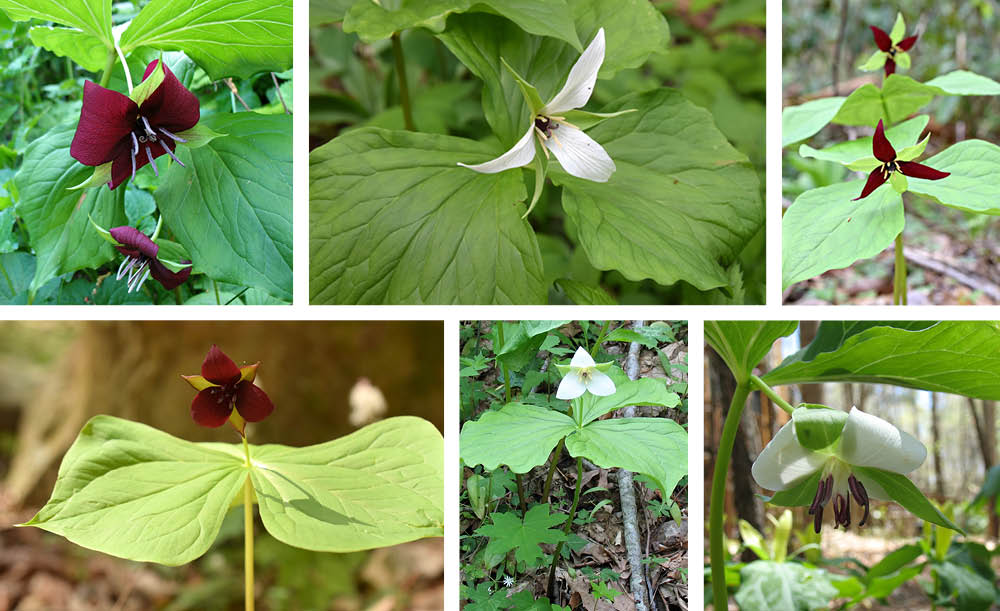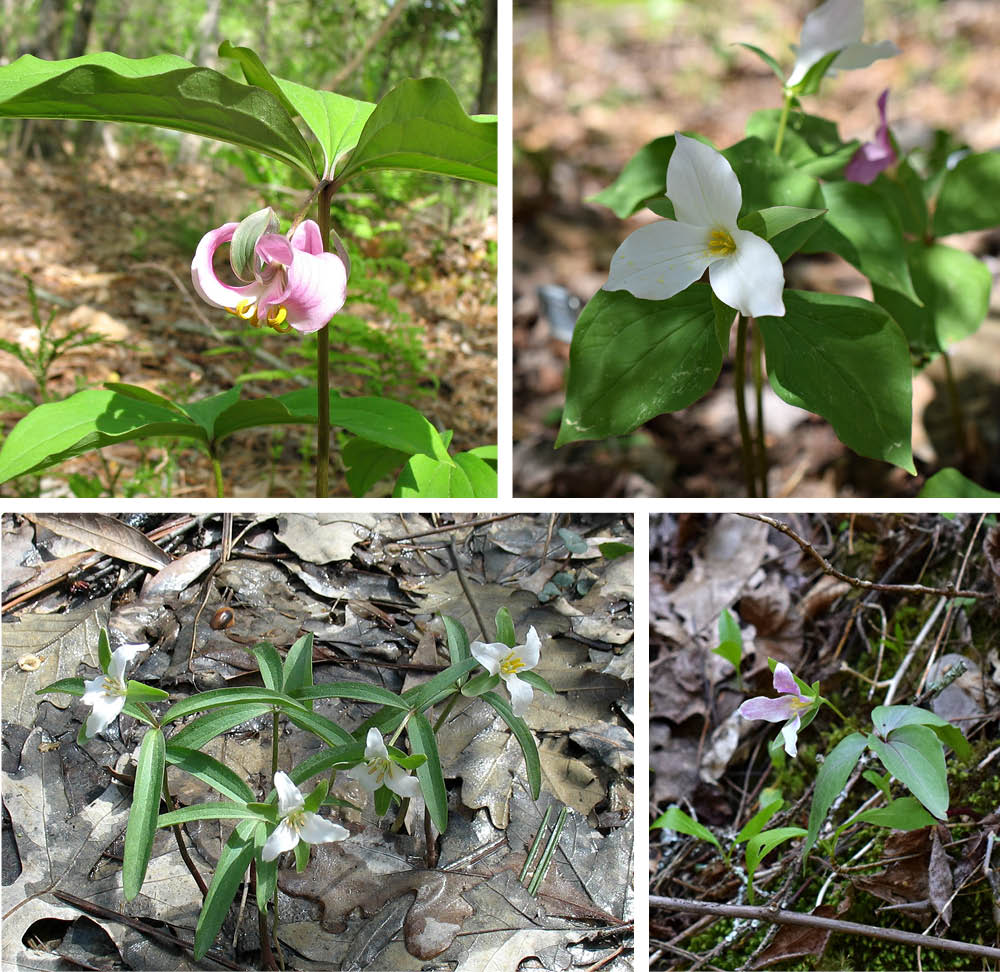Last month I wrote about Georgia trilliums and focused on the ones with sessile flowers: the flower sits directly on the mottled leaves. I referenced information by Tom Patrick and noted that he referred to those species as the Toadshade trilliums. This month I’ll finish up with what he called the Wakerobin trilliums. These trilliums have pedicel stalks that hold the flower away from the green leaves.
There are 12 species of trilliums in Georgia that fall into this group and Tom divided them into 3 smaller groups: the erectum group of species; species whose white flowers age to pink; and one trillium that doesn’t fall into either group. I find his groupings useful and will use them here as well.
Some representatives of the erectum group of species, clockwise from top left: Trillum vaseyi, T. simile, T. erectum, T. rugelii, T. flexipes, and T. sulcatum.
The erectum complex is a group of trilliums whose flowers are held above or below the leaves but whose petals do not change colors over time. The species in this group include: Trillium erectum, T. flexipes, T. rugelii, T. simile, T. sulcatum, T. vaseyi, and an as-yet-unnamed species called Amicalola trillium.
Trillium erectum is found in far north Georgia and it is the species from which at least 3 of the others used to be associated. The petal color is red with occasional white individuals; the flower is held above the leaves. The ovary (in the center of the flower) is noticeably dark for this and several other species. Several common names reflect the unpleasant smell of the flower: stinking Benjamin, stinking Willie.
Trillium flexipes used to be considered a white form of T. erectum. The petals are creamy white and the flower is held above. One common name is bent trillium. A good place to see this one is at The Pocket at Pigeon Mountain; it is noted as only being found in Walker County.
Trillium simile is known as sweet white trillium or confusing trillium. It occasionally may have reddish petals, but it is usually white. You can distinguish it from bent trillium in Georgia by the location it is found as well as the color of the ovary (this one has a dark ovary while bent trillium has a pinkish one). Its fragrance is compared to green apples (a good way to distinguish it from T. erectum).
Trillium sulcatum was also once considered a variety of erectum. Like T. simile and T. erectum, it has a dark ovary. The petal color can vary on this one as well – from maroon to white and in-between; the flower is above the leaves. I have seen this one at Cloudland Canyon State Park.
Amicalola trillium is a late-blooming species with creamy-white petals and a pinkish ovary (which helps to distinguish it from erectum, simile, and sulcatum). The flower may be held above the leaves or just below.
Trillium rugelii is known as Southern nodding trillium because the cream-colored flowers hang down below the leaves, a trait that it shares with Catesby’s trillium—however, this species is generally much larger than Catesby’s trillium and the petals do not turn pink with age.
Trillium vaseyi is a large, late-flowering trillium with maroon flowers. It was once considered a variety of erectum. Unlike erectum, however, the flower hangs below the leaves. Its range extends beyond North Georgia, with a few counties in the upper Coastal Plain reporting its presence in USDA.
The second group of trilliums includes (clockwise from top left); Trillium catesbaei, T. grandiflorum, T. persistens, and T. georgianum.
Four species make up the group of trilliums whose white flowers turn pink with age: Trillium catesbaei, T. grandiflorum, T. persistens, and T. georgianum.
Trillium catesbaei is identified by its low hanging flower, a trait not shared by any other in this group. As I mentioned earlier, it is similar to the Southern nodding trillium until its flowers turn a gorgeous pink. This is our most widespread of the white-to-pink trilliums; it is found from the northernmost counties down into the lower Coastal Plain.
Trillium grandiflorum is one of the showiest of our white trilliums, but it has only a very northern presence in Georgia. Seeing large sweeps of it on hillsides—such as in the Smoky Mountains—is a very spectacular sight.
Trillium persistens, often called Edna’s trillium, is a smaller, early blooming trillium with a limited range that is near the Tallulah Gorge area.
Trillium georgianum (formerly Trillium pusillum var. georgianum) is also quite small and quite limited in range (only one county in Georgia). Common names include dwarf trillium and least trillium. The range of the pusillum group of trilliums across the southeast is described here if you’re interested.
The last of the species to describe for Georgia is a lovely one. Painted trillium (Trillium undulatum) can have bluish-green leaves and a spectacular flower like no other. Wavy, white petals are usually splotched with red markings, as if they were painted. The range is very northern Georgia, about 4 counties and mostly the eastern ones.
Keep a look out for some of these special Georgia flowers this spring. Finding one is always a special occasion. Our abundance of trillium species is part of what makes Georgia special, too.


